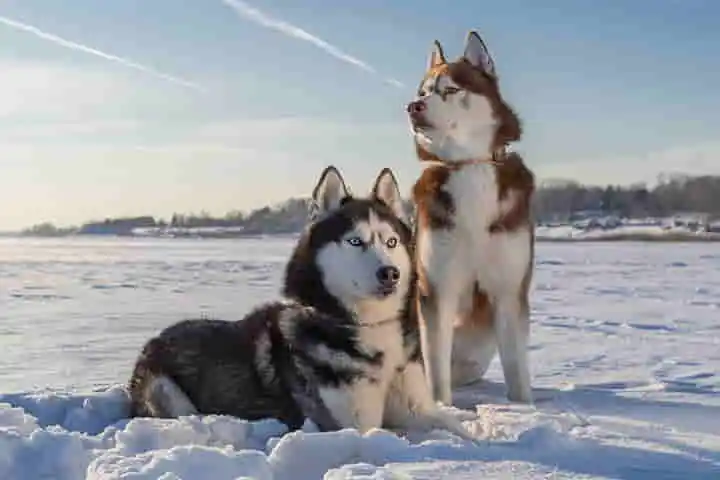

The analysis of DNA of dog pups thousands of years ago shows that there was interbreeding between the local species of Siberia and those from Europe and the Near East (Pic. Courtesy American Kennel Club)
<p>
<strong>In what can be described as an amazing discovery, the DNA analysis of the remains of Siberian dogs points to trading by ancient communities of the Arctic with the outside world as early as 7,000 years.</strong></p>
<p>
In an article in sciencenews.org it is reported that the analysis of DNA of dog pups thousands of years ago shows that there was interbreeding between the local species and those from Europe and the Near East. This was despite the fact that these dogs and their owners were living in a place which was one of the remotest in the world.</p>
<p>
This result in tandem with other archaeological evidence lends credence to the theory that Siberians had extensive trade connections that probably stretched up to the Mediterranean and the Caspian Sea.</p>
<p>
The details of this research was published last month in the Proceedings of the National Academy of Sciences.</p>
<p>
<strong>Also read: <a href="https://www.indianarrative.com/science-news/domestic-cats-hunt-to-satisfy-their-killer-instinct-and-not-for-food-119153.html">Domestic Cats Hunt To Satisfy Their Killer Instinct And Not For Food</a></strong></p>
<p>
The four-legged furry animals have been a constant and beneficial companion of human beings in the Arctic for more than 9,500 years. They were widely used for hunting, sledding, reindeer herding, food and clothing. Given the remote location of the region, scientists thought that both the dogs and their human owners were entirely isolated from the world. This theory was endorsed by the fact that there was not much exchange of DNA of the Siberians with those of people outside, said Tatiana Feuerborn, who is an archaeologist at the University of Copenhagen.</p>
<p>
However, there was other archaeological evidence found earlier that did suggest that these remotely located communities did have trading ties with others beyond the Arctic. The evidence included discovery of glass beads and other foreign goods entombed alongside 2,000-year-old dogs near the Yamal Peninsula in Russia.</p>
<p>
When Feuerborn came to know about this evidence, she was eager to check if these remains of 2,000-year-old dogs could help in unveiling of the trade network which existed in the past.</p>
<p>
It is important to note that dogs do not go far way from human owners, so it meant that the scientists could according Kelsey Witt <a href="https://www.sciencenews.org/article/dog-dna-ancient-trade-network-arctic-siberia-europe-near-east">&ldquo;use dogs to understand human movement, like migrations</a> and even trade interactions&rdquo;. Witt from Brown University in Providence, Rhode Island is a geneticist who is not connected with this study. In the past too, archaeologists had used the DNA of ancient dog to push back the arrival date of people in the Americas.</p>
<p>
Along with her colleagues, Feuerborn analysed the DNA taken from the remains of 49 Siberian dogs. The samples ranged from bone fragments which were 11,000-year-old to fur hoods that were used at the turn of the 20th Century by Arctic explorers. What the researchers uncovered is that unlike their owners, the Siberian dogs had mated and mixed with other dog populations. The dog groups they had mixed with were from the Near East, Eurasian steppes, and Europe and their meeting dated as far back as 7,000 years.</p>
<p>
<strong>Also read: <a href="https://www.indianarrative.com/science-news/cannibalism-in-australian-cane-toads-triggers-evolutionary-changes-112393.html">Cannibalism In Australian Cane Toads Triggers Evolutionary Changes</a></strong></p>
<p>
The conclusions drawn from the study do hint that the Siberians brought dogs from outside their region, said Feuerborn. Besides, these links through trade may have been instrumental in bringing in new ideas and techniques, like working with metals to the Arctic and also moving to reindeer herding instead of foraging in the last 2,000 years.</p>
<p>
Summing up Feuerborn said: &ldquo;Dogs are a piece of our past. By looking at them, we can learn something about ourselves.&rdquo;</p>
External Affairs Minister S Jaishankar on Tuesday called on member nations of the Shanghai Cooperation…
External Affairs Minister S Jaishankar held a meeting with his Russian counterpart, Sergey Lavrov, on…
The ongoing bilateral trade talks (BTA) negotiations by India and the United States (US) are…
By Shailesh Yadav Petroleum and Natural Gas Minister Hardeep Singh Puri emphasised that sufficient energy…
Mongol, Tibetan, and Japanese communities from across the Tokai region of Honshu Island gathered in…
Indian astronaut Subhanshu Shukla's 15-day mission in space will play a crucial role in India's…